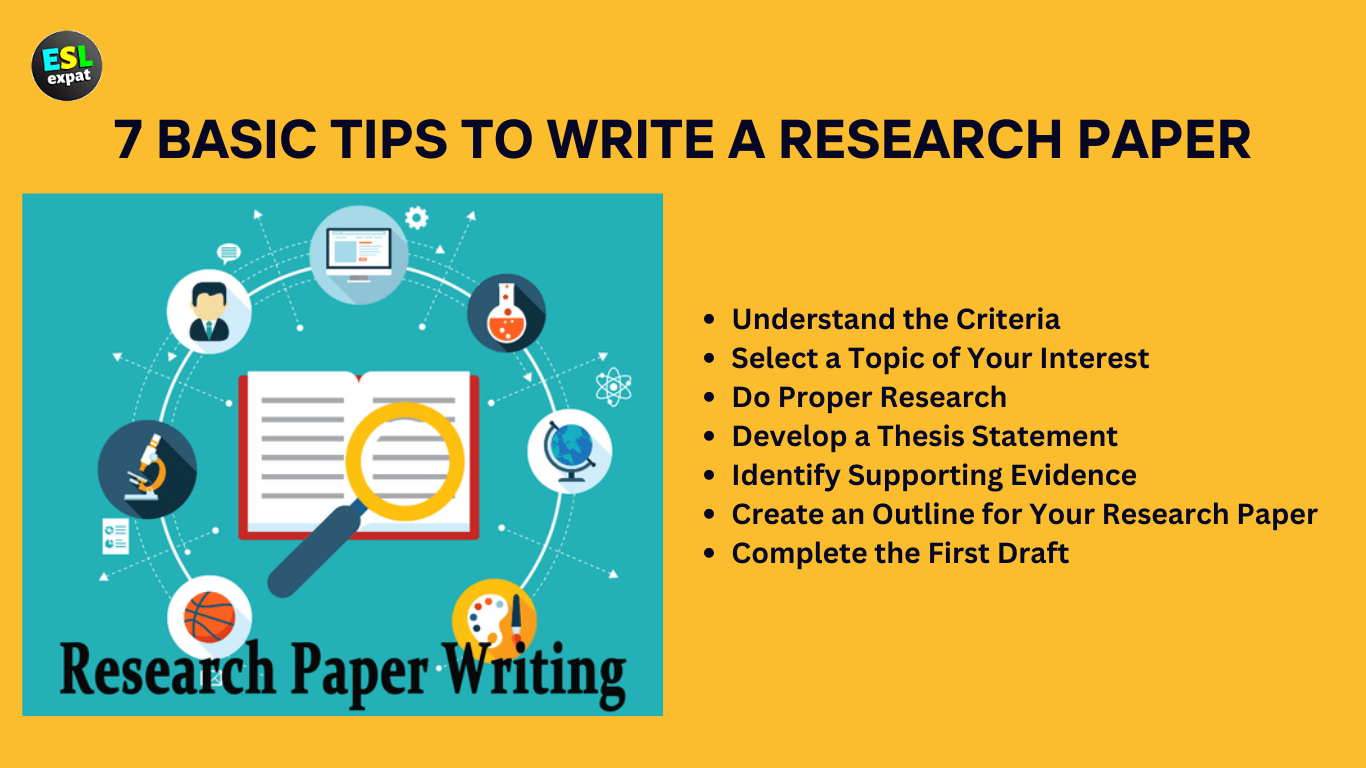|
Download ESL Books + Free PDFs
Save 25% on ESL Books for Teachers & Students Visit the ESL Expat Store and enter "SAVE25" at checkout! |
A research paper is a piece of academic writing that contains in-depth independent research analysis, interpretation, and argument.
Academic essays are comparable to research papers, but they are usually longer and more extensive assignments designed to examine not only your writing tactics but also your scholarly research skills. Writing a research paper demands you to exhibit a thorough understanding of an issue, engage with a number of sources, and contribute something unique to the argument.
This step-by-step guide will walk you through the whole writing process, from comprehension of your research paper to proofreading your final product.
But getting right into it, let’s have a look at basic definition of a research paper.
What Exactly is a Research Paper?
A research paper is a sort of academic writing in which an in-depth analysis, appraisal, or interpretation of a single topic is provided based on facts.
Research papers are the most effective means to communicate information across a large network and are the foundation of modern research. Most individuals, though, are familiar with research papers from school; college courses frequently employ them to assess a student’s understanding of a certain field or their research skills in general.
Given their importance, research papers use professional, even boring language that removes any bias from the writing. Researchers present their findings clearly and with supporting data so that other researchers can utilize the publication in their own research.
Remember that writing a research paper is not the same as drafting a research proposal. Essentially, research proposals are used to obtain the financing required to collect the data needed to write a research article.

7 Foolproof Tips to Writing a Research Paper
The following are some tips to drafting a research paper. While certain procedures may not apply to your specific assignment, consider this a general guideline to keep you on track.
Understand the Criteria
This may seem obvious to some of you, but you might be astonished at how many students begin a research paper without ever reviewing the criteria.
So, your first step should be to go over the criteria and study the writing prompt thoroughly. Look for technical requirements like length, formatting (single- vs. double-spacing, indentations, etc.), citation style, percentage of plagiarism, and many more.
Take note of the specifics, such as if you there’s any specified percentage of plagiarism, it is compulsory to check with the help of a plagiarism detector.
Like if there’s a requirement that your research paper must contain maximum plagiarism of 10% then the only option to determine that percentage is; take assistance from a plagiarism detector.
Once you comprehend the task, the next steps in how to write a research paper are similar to the typical writing procedure. There are some additional procedures because research papers have additional rules, but the idea of the writing process remains the same.
Select a Topic of Your Interest
The student must choose their own topic for open-ended tasks. While it may appear straightforward, selecting a topic is the most critical decision you’ll make when writing a research paper because it impacts everything that follows.
When deciding how to choose a research paper topic, your first focus should be if it will provide enough information and depth for a complete research paper. Choose a topic with enough data and complexity to allow for a rich conversation. However, you should avoid broad topics and instead stick to topics that are narrow enough that you can cover all necessary information without cutting too much.
However, try not to be robotic in your topic selection; it is still ideal to choose something that you are really interested in. Ideally, you’ll select a topic that meets both needs, providing a sufficient amount of knowledge while also keeping you engaged.
Do Proper Research
The earlier you begin your research, the better you’ll get the results, it’s called a research paper for a reason. Find out what research is available for your issue as soon as feasible to refine your topic and create your thesis statement. Early research will help debunk any misunderstandings you may have about the subject and identify the best methods and approaches to finding additional material.
Typically, sources can be found online or in a library. When conducting an online search, make sure to choose reliable sources such as scientific journals or academic papers.
As you search, keep the distinction between primary and secondary sources in mind. Primary sources are firsthand accounts, such as published articles or autobiographies, whereas secondary sources are more distant, such as critical reviews or secondhand biographies.
When conducting research, it is preferable to skim sources rather than reading each potential source thoroughly. If a source appears to be useful, you can employ a paraphrase tool to better understand the content. Otherwise, you’ll be wasting time pouring over sources you’ll never use, time that could be better spent locating a useful source.
A paraphrase tool will reword the source text and let you understand a that text using variety of vocabulary.
You may be asked to produce a literature review that explains your sources and presents them to an authority for approval. Even if no literature review is required, compiling a list of probable sources early on is beneficial—you’ll be glad you did later.
Develop a Thesis Statement
Write a thesis statement that highlights what your research paper will be about based on what you discovered in your preliminary investigation. This is frequently the first sentence of your paper, and it serves as your reader’s introduction to the subject.
A thesis statement is the finest way to begin a research work. Aside from prepping your reader, the thesis statement also assists other scholars in determining whether or not your paper will be valuable to them in their own research. Similarly, study the thesis statements of other research articles to determine their usefulness to you.
A strong thesis statement covers all of the main points of the topic without revealing too many specifics. If you’re having problems putting your thoughts into words, try framing your issue as a question and then answering it.
Identify Supporting Evidence
It is now time to knuckle down and do the actual study for how to create an academic research paper. This is the stage at which you comb through all of the sources you gathered earlier and discover the precise information you want to utilize in your paper.
Typically, you gather supporting evidence by reading each source and taking notes. Isolate only the material that is directly relevant to your issue; avoid tangents or unneeded context, no matter how entertaining they may be. Always take note of page numbers, not just so you can access the content later, but also so you may cite it.
In addition to underlining material and taking notes, bibliographic cards are a popular strategy. These are straightforward index cards with a fact or direct quotation on one side and bibliographical information (source citation, page numbers, subtopic category) on the other. While bibliography cards are not required, some students find them essential for remaining organized, particularly when writing an outline.
Create an Outline for Your Research Paper
Many students are interested in learning how to make a research paper outline. Outlines are extremely crucial in research papers since they require a rigorous and systematic framework to ensure that all concerns are addressed.
Create an outline for your outline by first making a list of all the essential categories and subtopics you need to cover. Consider all of the material you obtained when creating your supporting evidence and determine the best way to separate and organize it.
Once you’ve decided what to talk about, think about the best way to communicate the material. Which subtopics are connected and should be placed next to one another? Are there any subtopics that make little sense if presented out of order? If your information is reasonably basic, you can use a chronological approach and present it in the order it occurred.
Because research papers might be lengthy, consider dividing your outline down into paragraphs. For starters, if you have a lot of stuff to cover, this will help you keep organized. It also allows you more control over the flow and direction of the study paper. It is always preferable to repair structural issues at the outline phase rather than after everything has been written.
Remember to include your supporting evidence in your outline as well. You’ll probably want to include a lot, so placing everything in your outline prevents certain items from falling through the cracks.
Complete the First Draft
Once your outline is complete, you can begin drafting your research report. This is considered as the time-consuming and difficult step, but if you’ve carefully prepared your materials and produced a thorough plan, everything should go in a flow.
The beginning of a research paper can be challenging if you don’t know how to create an introduction for it. That is why it is critical to write your thesis statement ahead of time. Start with your thesis statement, then fill out the rest of your introduction with secondary information, save the details for the body of your research paper, which follows.
The body of your research paper contains the majority of its content. Unlike essays, research papers frequently break the content of the document into sections with separate headers to make browsing and scanning easier. As a guide, use the divisions in your outline.
Follow your outline and go paragraph by paragraph. Don’t worry about getting every word flawless because this is only the first draught. You’ll be able to rewrite and fine-tune your writing later, but for now, just say what has to be said. In other words, it’s fine to make mistakes because you’ll go back and fix them afterwards.
What Should the Length of a Research Paper be?
The length of a research paper varies according to the topic or assignment. Typically, research papers are 4,000-6,000 words length, but short papers of 2,000 words or long papers of 10,000 words are typical.
If you’re writing a school paper, the recommended length should be specified in the assignment. Otherwise, let the length be determined by your topic: Complicated topics or lengthy investigation will necessitate additional explanation.
Conclusion
One of the most typical issues in writing lengthy content such as research papers is connecting paragraphs. The longer your writing, the more difficult it is to weave everything together smoothly.
Use transition sentences to improve the flow of your writing, particularly the opening and last lines of each paragraph. Even after you’ve completed the body, you’ll need to know how to write the conclusion of your research paper.
In your conclusion, don’t offer any new material, but feel free to share your personal perspective or interpretation if it helps the reader appreciate the overall picture.
Do you have a story about teaching or learning English?
Submit your story and it could get featured in our next blog publication.
Read more stories on the blog.
Related Blog Articles:
- How Can You Write Plagiarism-Free Content for Your Website?
- How To Choose The Best Essay Writing Service
- 5 BEST Free Plagiarism Checkers in 2023
- 4 Main Challenges of Academic Writing for ESL Students
